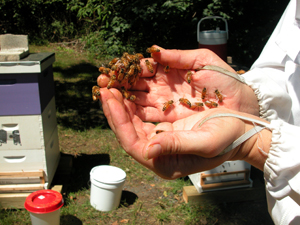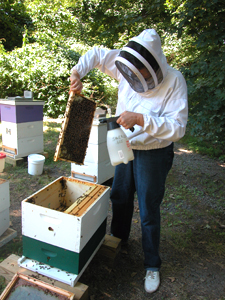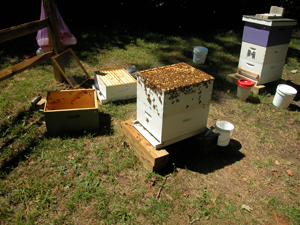 Back on June 28, we found a bee with a mite on it at the historic mill apiary, which raised an alarm about whether those colonies were seriously afflicted with the vicious varroa mites you have heard so much about here.
Back on June 28, we found a bee with a mite on it at the historic mill apiary, which raised an alarm about whether those colonies were seriously afflicted with the vicious varroa mites you have heard so much about here. The poor mite-bearing worker bee told us, in effect, that we have to treat sooner rather than later. Usually, I'd be waiting until the temperatures began to fall in September, and I would use a treatment that diffused a concentrated essential oil or formic acid (none of which are organophosphate pesticides, or leave toxic residues). However, it's far too hot for that, and we can't afford to wait. It's bad enough that we all could not find a suitable date to work together before this!
Why do I say "we?" MaryEllen has bees there, too, and it's safest to assume that what is living in one hive has also reached out to the neighbors. MaryEllen's presence in this post is important for another reason, too. She and her husband, Doug, used a treatment called "sucrocide" to treat some of their colonies last year, and those colonies registered not one single mite when tested. Not one! So we decided to try sucrocide at the Mill. It's a bit tricky unless you have done it before, so I wanted their help.
The sucrocide treatment meets our standard for keeping poisons out of the hives. It is made up of a tobacco leaf extract and sugar, and it works by drowning the mites, and then disappearing from our lives. It really stuns the bees at first, too, but they are larger and shake it off as they dry. The mites are much smaller, and evaporation comes too late for them. Another bonus: it's really unlikely that the mites will ever develop resistance to this treatment, unless they can evolve beyond a need for oxygen.
 The picture up top shows bees recovering from what I am doing in this picture: spraying sucrocide from a pump sprayer onto each side of every single frame in the hive, as well as the sides. We try not to spray Queen Maud or any open brood. By the way, this exercse has to be repeated 3 times, at one week (or so) intervals. Hard work.
The picture up top shows bees recovering from what I am doing in this picture: spraying sucrocide from a pump sprayer onto each side of every single frame in the hive, as well as the sides. We try not to spray Queen Maud or any open brood. By the way, this exercse has to be repeated 3 times, at one week (or so) intervals. Hard work. The bees cling to my hands in a sort of drunken, but insistent, way. They really hang on, holding my skin with the hooks on the end of their legs that they also use when hanging together to drawn honeycomb. You cannot shake them off easily. It kind of feels like the "pins and needles" effect when you cut off circulation to a foot or hand. I like holding the clingy bees, but it freaks out MaryEllen and Doug. I just thought about how they were very wet and sort of cold, and how my hands were warm and in the sun.
 When applying the sucrocide, though, we found ourselves disassembling hives full of bees in hot weather, and reassembling them into hives of sodden bees who just wanted to climb up out of the box to catch some rays and dry off. Kind of a bee-cano, since my colony out there is just brimming with bees, easily a peak sort of population for a hive around here. This picture is actually MaryEllen's colony, though. Those boxes get heavy at midsummer, and they are very heavy to settle down gently, one on top of the other, while trying to gently convince wet bees to move along. Thank goodness we did this together!
When applying the sucrocide, though, we found ourselves disassembling hives full of bees in hot weather, and reassembling them into hives of sodden bees who just wanted to climb up out of the box to catch some rays and dry off. Kind of a bee-cano, since my colony out there is just brimming with bees, easily a peak sort of population for a hive around here. This picture is actually MaryEllen's colony, though. Those boxes get heavy at midsummer, and they are very heavy to settle down gently, one on top of the other, while trying to gently convince wet bees to move along. Thank goodness we did this together!Though actually, I will be away for the final treatment. MaryEllen, Doug and I did the first treatment together on July 30, a week ago. MaryEllen and I did it today, and Doug has agreed to complete the process next week, when I go off to a wedding in Ireland (can you believe it?)
I am getting seriously bent out of shape about having to leave on Tuesday. This has been a trend in recent years: I like to travel, but hate to leave home. Adding the bees to my life has not made this easier, but not, perhaps, for the reason you would think. Sure, there is extra preparation before leaving, but I think the real issue is how connected I feel to the pile of dogs, cat, fish, bees, bird feeders, friends, neighbors, plants, and even squirrels about the place. Departing my eco-system for someone else's is good for the mind and for the soul, but it can be kind of hard on the heart.
4 comments:
I feel the same way about leaving home. I am so attached to my critters and everything- I love to travel, it's the leaving that I hate. We have a sitter, but I still feel anxious about leaving.
My friend and mentor MaryEllen emailed the following to me, being too polite by half to correct me in public! The thing is, I want to be straightened out!! Here is what MaryEllen said about how this mite treatment works:
"I did want to comment on the mode of action of the sucrocide though. It doesn’t drown the mites. It works in the same way as oxalic and formic acids do actually. These substances act on the outer shell of the mites to weaken it so that the mite actually dehydrates. Because the mite is so much smaller than a bee, the amount you use as a lethal dose for mites does not act the same way on the outer shell of the bee. Bees also groom. This is just for the sake of clarity."
Now, I want to extend an offer to ANYONE out there with either corrections or questions to leave a comment here. Almost as much as the bees, I have enjoyed the wisdom, help and honesty of beekeepers, so pamper me with more of your words!
Hello,
My name is Danya and I am a Virginia Tech student making an educational documentary on varroa mites and the effects they have on bees. I was wondering if there was any way to use to the photo you have on your blog of spraying sucrocide on the hive. We are doing a section on how to prevent the spread of mites, and this picture would be perfect. I sent an email your your AOL account, so if there is any way you could respond to that, that would be great. Thanks again.
Hey Danya -- the AOL account is for IM only, which you probably found out by noww! My contact info is available at http://www.tonitoni.org/faq.html#contact (I don't like to repeat my email in lots of places because it generates spam).
I'd be happy to let you use that picture, and I have it and others at higher resolution. By the way, the hive you see there is in Virginia!
Post a Comment